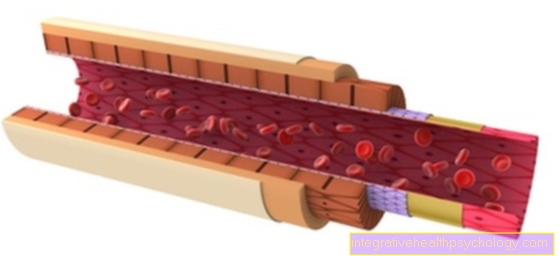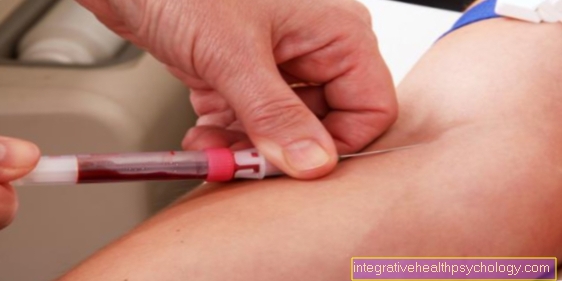Hemarthrosis
Definition - what is hemarthrosis?
In medicine, hemarthrosis is a bruise within a joint (joint bruise). Compared to a hematoma, which can form anywhere in the body, it is found inside joints (knee or shoulder joint). The accumulation of blood is usually visible in the form of a swelling and a bluish discoloration of the skin. The increased formation of blood is usually due to a serious injury in the joint area (e.g. torn ligament or cartilage damage in the knee joint).
Read more about the topic here: Joint swelling in the knee

Symptoms and pain
The nature of the symptoms depends on the size and extent of the hemarthrosis. With a small bruise there is only a slight swelling of the joints and a slight pain on pressure. If a larger joint hemorrhage develops, there is not only a significant swelling but also a very painful tension pain. This comes about because the space inside the joint is reduced due to the massive accumulation of blood. This leads to a significant reduction in mobility.
Swelling
The formation of a swelling is a typical, clearly visible symptom. Due to the abnormal, increased formation of blood in the joint, the veins running there are no longer able to sufficiently transport the blood away. Because of this, swelling occurs. Sometimes the skin can also heat up.
For more information on swelling, see the following article: Joint swelling
Treatment of hemarthrosis
The focus of treatment is the prompt removal of the bruise from the joint, since if left untreated, it will either lead to infections or to lengthy consequential damage. Conservative, symptomatic therapy consists of immobilizing, cooling and elevating the affected joint with a possibly light compression bandage.
In addition, pain reliever therapy with pain relievers (analgesics) can be used. If blood clotting disorders are the cause, these must be precisely diagnosed and remedied using appropriate medication.
When does a hemarthrosis have to be punctured?
If the bruise cannot heal by itself despite all the measures taken, a puncture or a joint puncture is performed. Since this procedure involves piercing the joint directly with a sterile needle (hollow needle), this procedure should be carried out under absolutely sterile (germ-free) conditions in order to avoid inflammation (infection) of the joint.
During the puncture, the blood is sucked out through the advanced needle. This reduces the pressure within the affected joint and the patient usually feels an immediate, significant relief of the symptoms. The punctured blood can then be examined for its components in the laboratory, whereby a bacterial infection can be excluded.
Find out more about: Knee puncture
What are the causes of hemarthrosis?
There are various possible causes for the development of hemarthrosis. This is often caused by acute, traumatic injuries to joints and their structures such as B. a serious knee injury. Hereditary or chronic diseases that lead to blood clotting disorders are also reasons for the formation of a joint hemorrhage. An example of this is hemophilia. It is an inherited blood clotting disorder that mostly affects men.
For more information on the causes of hemarthrosis, see the following article: Ligament injury on the knee
Where can hemarthrosis occur?
A joint bruise can basically occur in all joints. Often, however, it occurs in the area of the knee or shoulder joint, as these two types of joint are particularly stressed in everyday life. Underneath the kneecap (patella), hemarthrosis can lead to a so-called “dancing patella” (“dancing kneecap”). Due to the bruise that has formed under the kneecap, it can be clearly shifted in several directions or "dance" on the effusion.
You can find out more about the topic here: Bruise in the knee
How long does hemarthrosis last?
Small accumulations of blood usually recede after a few days through cooling, elevation and protection of the affected joint. Larger bruises should heal within a few weeks with appropriate treatment and removal of the cause. If this is not the case, protracted, painful restrictions on movement can result. In addition, the loss of healthy tissue (necrosis) can occur as this is no longer adequately supplied due to the hemarthrosis.
How is the diagnosis of hemarthrosis?
In addition to a thorough physical and symptomatic examination by the attending physician, the ultrasound examination (sonography) is used to show the size and extent of the bruise. For further diagnostics, an MRI (magnetic resonance tomography) should be performed in order to make existing injuries or damage within the joint visible.
In addition, a small blood count can be useful, whereby an inflammation in the joint can be proven as the cause. In this case, the inflammatory parameters in the patient's blood are increased. At the same time, the blood coagulation parameters are also checked in the laboratory via the blood count, because disturbed blood coagulation is also a cause of hemarthrosis.
What is the prognosis for hemarthrosis?
The prognosis depends on the cause. In principle, early diagnosis and adequate treatment are important in order to avoid permanent consequential damage to the affected joint. In very rare cases, the hemarthrosis must be surgically removed in order to prevent further pathological impairment of the joint and its surrounding structures.
Possible complications
One possible complication is arthrofibrosis. Arthrofibrosis is a pathological, increased formation of connective tissue (connective tissue cells) due to inflammatory processes. Arthrofibrosis is a very common complication after major joint operations such as knee surgery.
Due to the increase in connective tissue, scar tissue forms inside the joint, which leads to a long-lasting, significant restriction of movement with or without pain. In most cases, this must be removed in another operation in order to restore sufficient mobility.





























